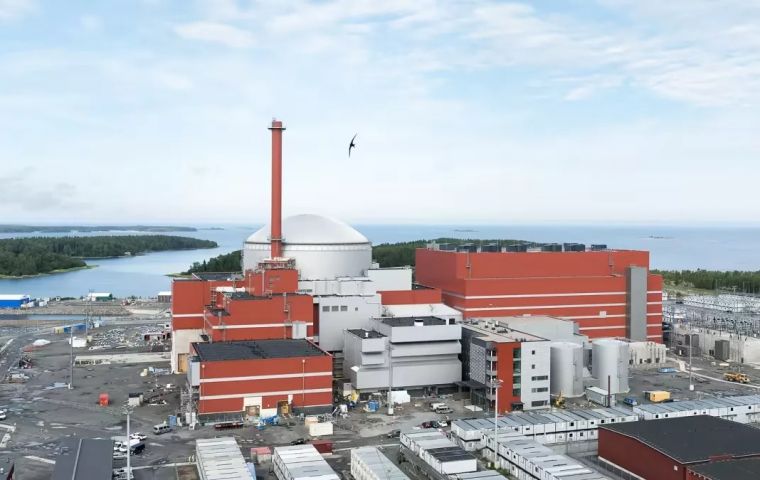MercoPress. South Atlantic News Agency
Finland connects nuclear plant to power grid; EU classifies nuclear as 'sustainable energy'
 The 1.6 Giga-watt (GW) reactor, built by the French-led Areva-Siemens consortium, had originally been due to open in 2009.
The 1.6 Giga-watt (GW) reactor, built by the French-led Areva-Siemens consortium, had originally been due to open in 2009. Finland's long-delayed Olkiluoto-3 nuclear reactor connected to the power grid for the first time this month, the plant's operator said, 12 years after its planned launch. Located on Finland's west coast, Olkiluoto-3 is the country's first new nuclear plant in over four decades and Europe's first in almost 15 years.
The inauguration has also triggered a debate as to the definition of green energy for the European Court of Justice and even the European Parliament and which environmental organizations are challenging because they classify nuclear power and gas as sustainable energy sources. They argue the green investment should not go to these industries.
The 1.6 Giga-watt (GW) reactor, built by the French-led Areva-Siemens consortium, had originally been due to open in 2009. Using the third-generation European Pressurized Reactor (EPR) model, which was designed to improve safety and reduce costs, it was the first nuclear power station to be procured in Europe after the 1986 Chernobyl disaster.
Olkiluoto-3 was meant to be a showcase of French-German know-how, touted as offering higher power and better safety. But the project was plagued by technological problems and cost overruns.
The cost ballooned from an initial estimate of €3 billion (US$ 3.27 billion) to around €11 billion, according to the 2019 World Nuclear Industry Report.
The Finnish Economy Ministry and the country's nuclear regulator said the project was beset by a string of technical and safety setbacks due to poor project management and workmanship.
The repeated delays led to bitter compensation disputes between the Finnish operator TVO and Areva, with the latter ultimately agreeing in March 2018 to pay TVO financial compensation of €450 million.
Over time, Olkiluoto-3 is expected to reduce the need for electricity imports from Russia, Sweden and Norway and lead to lower prices. Olkiluoto-3 will run alongside two existing reactors, eventually becoming Europe's most powerful reactor.
Once regular energy production ramps up in July, the reactor will supply about 14% of Finland's energy at 1,650 megawatts, TVO said. “OL3 significantly improves Finland's electricity self-sufficiency and helps in achieving carbon neutrality goals,” the operator said in a statement.
Finland's net imports of power averaged 13 terawatt-hours (TWh) over the last few years, which should drop by around half by 2025 with Olkiluoto-3 in operation.
However, nuclear power remains controversial in Europe: while countries such as Germany are phasing out their nuclear reactors, citing safety concerns, France, Britain and others are planning new nuclear projects.
The Russian invasion of Ukraine has also focused minds on how to reduce Europe´s dependence on Russian energy and some politicians are highlighting nuclear as a self-sufficient, cheaper alternative.




Top Comments
Disclaimer & comment rulesCommenting for this story is now closed.
If you have a Facebook account, become a fan and comment on our Facebook Page!